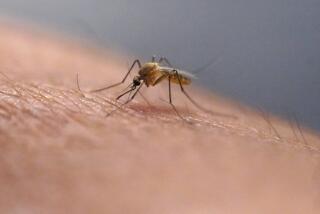To a skeeter, you’re a banquet
- Share via
They’re the rudest of uninvited visitors, and they’re out for blood. Mosquitoes show up at the most annoying times -- on an exposed wrist as you hurriedly tie a fly on a line or the back of a leg as you set up camp at dusk. Their persistence leaves some of us polka-dotted with itchy, red welts. For the truly unlucky, they can transmit diseases, including West Nile virus, which has made its way to Southern California.
The virus can cause mild flu-like symptoms or death. Though no cases of West Nile have been reported in California this year, it has been found in mosquitoes in Riverside County and in birds in Los Angeles, Riverside, San Bernardino and Ventura counties, according to the California Department of Health Services. Mosquitoes transmit West Nile by feeding on an infected bird and then biting a person. Of the three cases reported in the state last year, none was fatal, the agency said.
With 2,500 species of mosquito worldwide, sometimes it feels like the estimated 1 trillion blood-sucking arthropods are dive-bombing you at once. Don’t take it personally; they have good reason to want to bite you.
The females need the fat and protein that blood provides to produce eggs. A female mosquito will feed every three or four days, stuffing herself to nearly her body weight at every meal.
Contrary to what some believe, mosquitoes aren’t attracted to blue or any other color, says Lynn Kimsey, an entomology professor at UC Davis and director of the school’s Bohart Museum of Entomology.
One way to avoid blood donations to a hungry skeeter is to mess with her chemistry. Mosquitoes are attracted to the carbon dioxide, heat and lactic acid that humans emit; a repellent with the chemical DEET, short for N,N-diethylmetatoluamide, throws them off track.
“It turns off the signals for them to bite you,” says Kimsey, referring to a mosquito’s acute chemosensors used to detect warm-blooded creatures. Using DEET doesn’t kill the beasts, she says, but it “means they can’t find you; they don’t see you as food.”
Of the repellents available, Kimsey and other experts say DEET is the most effective. Developed for use by the military in the 1940s, DEET is available in a variety of products.
The higher the concentration of DEET, the longer it lasts, according to the Centers for Disease Control and Prevention. The CDC advises people to use just enough to cover exposed skin. A little of this smelly stuff goes a long way, so there’s no need to douse yourself. Toxic reaction is rare, but some may experience allergic reactions.
As for plant-derived repellents, such as citronella, soybean oil and certain herbs, none seems to match the effectiveness of DEET, although they haven’t been tested as extensively.
In a series of studies published in 2002 in the New England Journal of Medicine, non-DEET repellents provided at most 1 1/2 hours of protection. A formulation of 23.8% DEET lasted about five hours. The citronella-based repellents protected for 20 minutes or less, and wristbands laced with small doses of DEET or 25% citronella protected the wearer for only 12 to 18 seconds. Avon’s Skin-So-Soft bath oil, which has long been touted as a bug-banishing potion, provided a mean of 9.6 minutes of protection.
To avoid mosquitoes when camping or fishing, there’s “nothing better than a breeze,” says Jan Garcia, store manager of the REI store in Northridge. But what if the air is still? The best solution, says Garcia, is a “physical barrier.”
Ideally you should stay indoors or in a tent at dawn and dusk when mosquitoes are most likely to torment. Or you could cover your clothing from head to toe with mesh.
Outdoor catalogs and sporting goods stores offer mosquito head nets and no-see-um bug protection jackets, pants and even socks. Tight-weave fabric can keep probing mosquito proboscises from penetrating through to skin.
The latest bug protection in the outdoor world is Buzz Off clothing, made by Ex Officio and Orvis. The fabric of the shirts, pants, socks and bandannas is bonded with the insecticide permethrin, which the manufacturers claim lasts for about 25 washings.
Meant to be used on clothing, not skin, permethrin is a man-made version of a substance called pyrethrum that occurs naturally in chrysanthemums. Permethrin is a pesticide that kills insects by damaging their nervous systems, according to the U.S. Environmental Protection Agency.
You can also buy some and spray it on clothing yourself, which, according to the CDC, is safe to do.
But some recoil at the thought of using repellents and are resigned to being bug bait. Scott Gediman, a public information officer at Yosemite National Park, where the mosquitoes are already biting at Tuolumne Meadows, says he knows he’s a mosquito magnet.
But he doesn’t like sticky repellents and so usually ventures out bare-skinned. “I get bitten a lot. It’s part of the game.”
To e-mail Julie Sheer or read her previous Outdoors Institute columns, go to latimes.com/juliesheer.
More to Read
Sign up for The Wild
We’ll help you find the best places to hike, bike and run, as well as the perfect silent spots for meditation and yoga.
You may occasionally receive promotional content from the Los Angeles Times.





